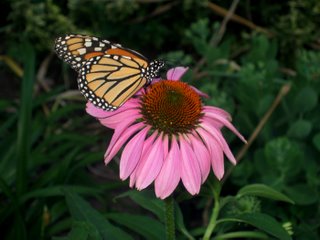Monarch migration

It is that time of year when the monarch butterflies stop by my garden on their journey south.
The fall migration of the monarch butterfly begins in Canada and the northernmost parts of the United States in late August ending in the months of November and December. The destination lies in Central Mexico, in the Oyamel forests, the overwintering site in the Transvolcanic Plateau of Mexico. As many as 300 million spend the winter there. Distances as great as 3,100 miles are travelled during their migration, traveling roughly 50 miles per day, at speeds measured at 12 miles per hour.
During the migration, monarchs encounter many dangers including storms, being crushed by cars, and eaten by birds. The long journey takes its toll and many can be seen limply trying to keep aflight, ready to collapse at any moment. Even after the monarchs arrive at their winter retreats, the danger of storms is still a major factor on the survival. The danger is greater, particularly in Mexico, where temperatures, strong winds, and snow kill thousands.
This migration takes up to three generations to complete! The exact migratory path is still being plotted today. Scientists are tagging the butterflies, and recording their locations during the months of the fall migration.
During the migration, the monarchs feed extensively on flowers to gain carbohydrates from nectars which fuel daily activities and contribute to the build up of the fat body in the abdomen. Once they have reached their roosting site, they cluster in large numbers in the branches and trunks of the oyamel trees. While clustering they remain quiescent (they stay relatively sill and maintain low metabolic rates). In mid-February, the monarchs at the roost sites become more active and mating behavior begins. By the end of February, some of the monarchs begin moving northward, by mid-March the roost is usually depleted.
The spring migration starts out with only about half of the original roosting population returning to their homes. Forty to sixty percent of the monarchs die during their stay in Mexico. Along the way, they roost and reproduce, giving rise to new butterflies that will continue the spring flight back.


1 Comments:
Interesting. That would be cool to see them roosting in Mexico!
Post a Comment
<< Home